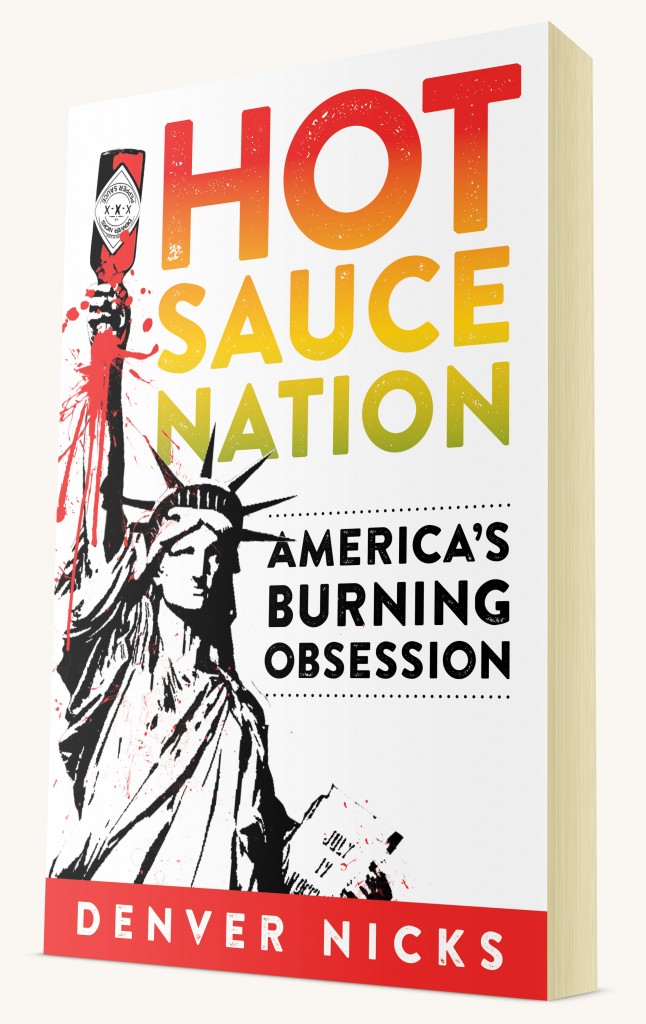 In 2012, after a couple grueling, draining years researching and writing a biography of US intelligence whistleblower Chelsea Manning, author and regular TIME contributor Denver Nicks was looking for a lighter subject. That’s when it dawned on him how little he actually knew or understood about hot sauce, a condiment he’d loved since childhood, so he embarked on a trip across America and even to several places abroad to learn more about how it’s made and the spicy fruit it’s derived from, the chili. His research into peppers eventually took a turn for the profound, and the book he’s putting out on October 1, Hot Sauce Nation: America’s Burning Obsession, is part history, part scientific inquiry, and part meditative travelogue exploring hot sauce’s takeover of the United States and the pleasure people get from the searing pain it causes. Here, Nicks answers a few questions about his adventures in the world of hot sauce and offers his takes on some popular and little-known brands.
In 2012, after a couple grueling, draining years researching and writing a biography of US intelligence whistleblower Chelsea Manning, author and regular TIME contributor Denver Nicks was looking for a lighter subject. That’s when it dawned on him how little he actually knew or understood about hot sauce, a condiment he’d loved since childhood, so he embarked on a trip across America and even to several places abroad to learn more about how it’s made and the spicy fruit it’s derived from, the chili. His research into peppers eventually took a turn for the profound, and the book he’s putting out on October 1, Hot Sauce Nation: America’s Burning Obsession, is part history, part scientific inquiry, and part meditative travelogue exploring hot sauce’s takeover of the United States and the pleasure people get from the searing pain it causes. Here, Nicks answers a few questions about his adventures in the world of hot sauce and offers his takes on some popular and little-known brands.
You did a lot of traveling for this book—to places where chilies are grown, to places where hot sauce is made, to restaurants, to festivals, etc. How much time did you actually spend on the road?
This is difficult to calculate, because for a long time it was more or less constant, but all in all more than six months. A lot of it, especially travel with other people, like my dad or my friend Aric S. Queen, was a blast.
What was the oddest place you found yourself?
I’m tempted to say Burning Man, but honestly probably the town of Hatch, New Mexico, where all those famous chilies come from. The place is really out there in the countryside, surrounded by farms, and such a small, rural place, but everywhere in town there are these enormous fiberglass figurines—and of weird stuff, like a bucket of KFC chicken, and Uncle Sam. It’s totally bizarre.
Your book also dives deep into the history and science of spice. Who were some of the experts who contributed most to your hot sauce education?
Paul Bosland—rightly self-described “Chileman”—of the Chile Pepper Institute in Las Cruces, New Mexico, is a national treasure. The man knows more, in both breadth and depth, about the science of chilies themselves than probably anyone else. I have to give a nod also to Matt Hudak at Euromonitor, with whom I had a conversation several years ago that helped pique my interest in the subject to begin with. There are so many others, but to keep it short I have to give a nod to Nietzche, who contributed mightily to my hot sauce education, not with respect to hot sauce specifically, but in terms of how we think about pain, which is what hot sauce is really all about.
You also found some real characters, including fanatical hot sauce consumers and makers. Who were some of your favorite people to talk to?
Baron Ambrosia, the hot sauce fiend currently organizing a license to bottle and sell hot sauce, is hands down one of my favorite new friends. He’s a force of nature and just a fascinating personality. Karl Leiker, who told me the story of how hot sauce figured into the love story between he and his wife, is a gem of a person. I was really thrilled have lunch with Dave DeWitt, the “Pope of Peppers,” and it was pretty amazing, frankly, to sit down with Tony Simmons, president of the company that makes Tabasco (and great-great-grandson of the guy who created the stuff), the bestselling hot sauce on Earth.
What were some of the books you found most valuable in the course of your research?
Jack Turner’s book Spice: A History of a Temptation, about Old World spices, was essential for helping me understand the full context of spices globally. Jean Andrews’ book Peppers: The Domesticated Capsicum is essential. The Hot Sauce Bible, by Dave DeWitt and Chuck Evans, is a good place to start for a real beginner on chilies, which, in the beginning, for all intents and purposes, I was.
 What was one of the most unusual recipes you saw hot sauce used in?
What was one of the most unusual recipes you saw hot sauce used in?
Milky hot chocolate at Annie Rupani’s chocolate shop, Cacao & Cardamom, in Houston. It makes perfect sense if you think about it, but it was a revelation for me. Also ice cream from Bonfatto’s. And the massively long list of the stuff people put Sriracha on, which encompasses basically everything that is edible and a few things that are not.
Gun to your head: Tabasco or Sriracha?
Tabasco. I love Sriracha, really I do, and I know how many people I will have crossed with that answer, but that’s my answer. Sriracha is a fabulous hot sauce and largely responsible for today’s artisanal hot sauce boom. But there’s a lot of sugar in it. Tabasco is chilies, salt, and vinegar, pure as the driven snow. I know it’s the Death Star of the hot sauce world, but I met the CEO, Tony Simmons, and he’s actually really nice. He’s certainly no Darth Vader. Tabasco is like the Beatles. It’s not the most interesting hot sauce out there, or even the best, but if someone who likes hot sauce says they just flat out don’t like it, they’re lying. Tabasco is awesome.
What’s a little-known hot sauce you think everyone should know about?
Moko Jumbie! It’s a small-batch hot sauce made in a suburb of New Orleans. It’s hard to find—it’s only for sale in real life at the Slidell farmer’s market and the bar Parasol’s in New Orleans—but you can buy it online, and it is really unique and just delicious.
-Geoff George
Hot Sauce Nation officially publishes October 1, 2016 and is available wherever books and e-books are sold.
[Get it now $18] [Request a review copy]
No Comments
No comments yet.